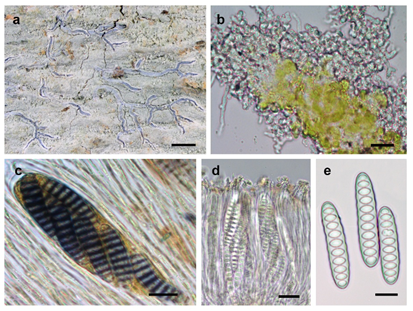Context:
Indian scientists from the MACS-Agharkar Research Institute, Pune, have identified a new species of lichen in the Western Ghats one of the world's most celebrated biodiversity hotspots. Named Allographa effusosoredica, this crustose lichen not only expands the catalog of India's unique flora but also deepens our understanding of symbiotic life forms and evolutionary complexity in tropical ecosystems.
Key Characterstics of Allographa effusosoredica:
· Its rare chemical makeup, including norstictic acid
· Its effuse soredia (structures involved in asexual reproduction)
· The presence of a Trentepohlia species as its algal partner
· Its mimicry of other lichens like Graphis glaucescens, which raises evolutionary questions about classification within the Graphidaceae family.
Modern DNA sequencing (mtSSU, LSU, RPB2, ITS markers) confirmed its close relation to Allographa xanthospora, offering new insights into genetic evolution.
About Lichens:
Lichens are not a single organism, but a symbiotic partnership — primarily between a fungus and a photobiont (usually a green alga or cyanobacterium). The fungus provides structure and protection, while the algal partner captures sunlight to produce food. Despite their small size, lichens:
- Build soil in barren landscapes
- Serve as a food source for insects
- Act as bioindicators of environmental health
This newly discovered lichen underscores just how much remains unknown about these subtle yet vital organisms.
Significance:
· The discovery highlights the intricate symbiosis between fungi and algae in lichens, with the algal partner, Trentepohlia species, playing a crucial role in the lichen's survival.
· The Western Ghats, where the species was discovered, is a recognized biodiversity hotspot, and this find emphasizes the importance of preserving such regions.
· The study sets new molecular benchmarks for the genus Allographa in the region, contributing to India's growing lichen inventory.
Implications:
· The discovery underscores the need for conservation efforts to protect the Western Ghats' rich biodiversity.
· The study highlights the urgent need for more molecular work on Indian lichen diversity, especially in biodiversity hotspots.
· The research contributes to our understanding of symbiotic life forms and their hidden genetic complexity, shedding light on the complex relationships between organisms in these ecosystems
Conclusion:
This research marks a major step forward in the understanding of India’s hidden biodiversity and symbiotic ecosystems. It emphasizes the need for more molecular-level research in biodiversity hotspots like the Western Ghats. It also reminds us that even in well-studied environments, nature continues to surprise — if we know where and how to look.
As climate threats intensify, protecting and studying organisms like lichens becomes not just a scientific priority, but an ecological necessity.







